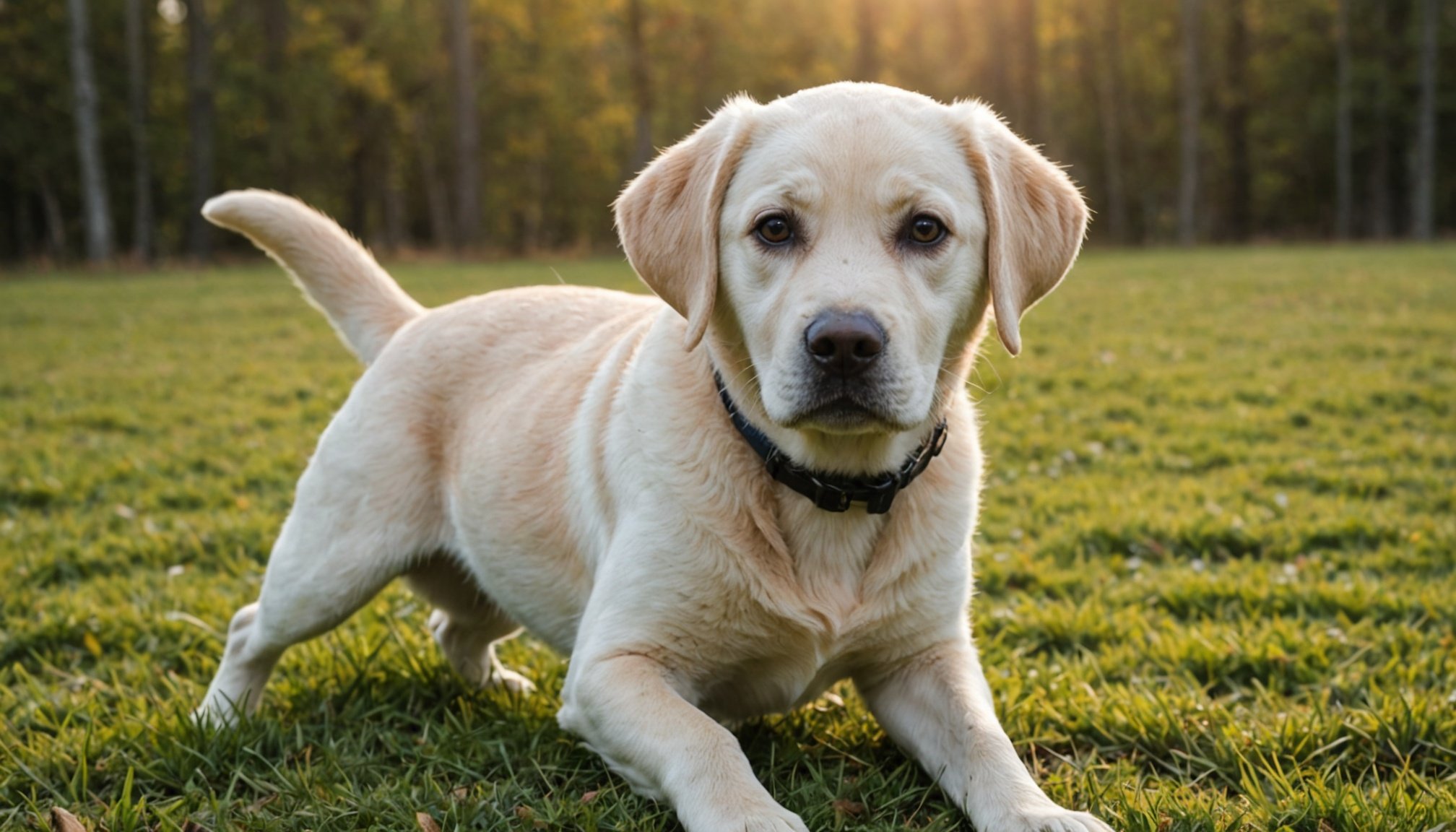Identifying Early Warning Signs of Hip Dysplasia in Young Labrador Retrievers: A Comprehensive Guide
Understanding Hip Dysplasia in Dogs
Hip dysplasia is a common and potentially debilitating condition that affects many breeds of dogs, particularly large and giant breeds like the Labrador Retriever. It is a polygenic and multifactorial developmental disorder characterized by coxofemoral (hip) joint laxity, degeneration, and eventual loss of function in the hip joints.
What is Hip Dysplasia?
Hip dysplasia occurs when the ball and socket of the hip joint do not fit properly, leading to friction and degeneration of the joints. This condition can be present from birth (early onset) or develop later in life due to various factors such as arthritis, obesity, and repetitive strain injuries.
Also read : Effective Strategies to Help Your Shetland Sheepdog Overcome Stranger Anxiety
Genetic and Environmental Factors
Hip dysplasia is influenced by both genetic and environmental factors. Genetically, it is a complex disorder involving multiple genes, making it challenging to eradicate from certain breeds. Environmentally, factors such as rapid weight gain, poor nutrition, and injuries can contribute to the development of hip dysplasia. For example, working dogs like K9s and Search and Rescue dogs are at higher risk due to the intense physical demands of their jobs.
Recognizing the Signs of Hip Dysplasia
Identifying hip dysplasia early is crucial for effective management and treatment. Here are some common signs to look out for in young Labrador Retrievers:
In parallel : How can I tell if my dog is getting enough exercise for their breed and age?
Clinical Signs
- Exercise Intolerance: Dogs with hip dysplasia may show reluctance to engage in physical activities or exhibit fatigue more quickly.
- Bunny Hopping: A characteristic gait where the dog moves both hind legs together, often seen when climbing stairs or running.
- Swaying Gait: The rear end of the dog may move back and forth in a pronounced fashion.
- Stiffness/Pain: Dogs may display stiffness, especially after rest or exercise, and may show pain when touched or manipulated.
- Difficulty Getting Up: Dogs may struggle to get up from lying or sitting positions.
- Frog Position: Sitting with one hip splayed out to the side.
- Hind-Limb Lameness: Lameness in the back legs, often worse after exercise.
Behavioral Changes
Dogs with hip dysplasia may also exhibit behavioral changes due to pain and discomfort. For instance, they might avoid activities that were once enjoyable, such as running or jumping. Here’s a detailed list of signs to watch for:
- Reluctance to run, jump, or climb stairs
- Evident pain when touched or manipulated
- Narrow stance with back legs closer together than front legs
- Sitting in unusual positions to alleviate pain
Diagnosing Hip Dysplasia
Diagnosing hip dysplasia involves a combination of physical examination, imaging tests, and sometimes genetic testing.
Physical Examination
Veterinarians will look for joint laxity (looseness) in the hips, which is an early indicator of the disease. In older dogs, they may check for muscle mass loss in the thigh muscles and enlargement in the shoulder muscles due to muscle compensation.
Imaging Tests
- Laxity Test (Ortolani Sign): This test involves rotating the hip joint to check for laxity. It is often performed under general anesthesia to avoid discomfort.
- X-rays: Critical for assessing the degree of joint degeneration and any impact on the spinal cord.
- Blood Tests: A blood chemical profile, including a blood count, electrolyte panel, and urinalysis, can provide additional information.
Genetic Testing
Understanding the genetic predisposition of your dog can help in early identification and management. While genetic testing cannot predict with certainty whether a dog will develop hip dysplasia, it can identify genetic markers associated with the condition.
Breeds Most Affected
Hip dysplasia can affect all breeds, but it is more common in large and giant breeds. Here are some breeds that are more genetically susceptible:
| Breed | Genetic Susceptibility |
|---|---|
| German Shepherd | High |
| Golden Retriever | High |
| Labrador Retriever | High |
| Rottweiler | High |
| Great Dane | High |
| Saint Bernard | High |
| Mixed Breeds | Variable |
Managing and Treating Hip Dysplasia
Early diagnosis is key to effective management and treatment of hip dysplasia.
Conservative Management
For mild cases, conservative management may include:
- Weight Management: Maintaining a healthy weight to reduce strain on the joints.
- Exercise Modification: Avoiding high-impact activities and focusing on low-impact exercises like swimming.
- Pain Management: Using pain medications and anti-inflammatory drugs.
- Physical Therapy: Physiotherapy and hydrotherapy to build muscle and improve joint mobility.
Surgical Options
For more severe cases, surgical interventions may be necessary:
- Pelvic Osteotomy: A surgical procedure to realign the hip joint.
- Total Hip Replacement: Replacing the damaged hip joint with an artificial one.
- Juvenile Pubic Symphysiodesis: A procedure for young dogs to promote proper hip joint development.
Preventive Measures
Preventing hip dysplasia or minimizing its impact involves several strategies:
Balanced Diet
A balanced diet tailored to your dog’s specific needs is crucial. Avoid overfeeding, as obesity can exacerbate joint problems. Ensure your dog’s diet includes essential nutrients for joint health, such as glucosamine and chondroitin.
Safe Exercise
Avoid excessive or improper physical activity, especially in puppies. Ensure that exercise routines are safe and do not put undue stress on the joints. For example, avoid running on slippery surfaces, which can lead to joint injuries.
Regular Check-Ups
Regular veterinary check-ups are essential for early detection and management of hip dysplasia. Even if your dog appears healthy, annual check-ups can help identify potential issues before they become severe.
Practical Advice for Pet Owners
Here are some practical tips to help you identify and manage hip dysplasia in your Labrador Retriever:
Monitor Your Dog’s Behavior
Keep an eye on any changes in your dog’s behavior, such as reluctance to exercise or signs of pain. Early detection can significantly improve the quality of life for your dog.
Maintain a Healthy Weight
Ensure your dog maintains a healthy weight through a balanced diet and regular exercise. Obesity is a significant risk factor for hip dysplasia.
Provide Safe Living Conditions
Avoid slippery surfaces and ensure your home is dog-friendly to prevent injuries that could exacerbate hip dysplasia.
Seek Professional Help
If you suspect your dog has hip dysplasia, consult with your veterinarian immediately. Early diagnosis and treatment can make a significant difference in managing the condition.
Hip dysplasia is a serious condition that can significantly impact the quality of life of your Labrador Retriever. By understanding the causes, recognizing the signs, and taking preventive measures, you can help your dog live a healthier, happier life.
As Dr. Jane Smith, a veterinarian specializing in orthopedic issues, advises: “Early detection and management of hip dysplasia are crucial. Regular check-ups and a proactive approach to your dog’s health can make all the difference in preventing long-term suffering.”
By being vigilant and taking the right steps, you can ensure your dog enjoys a life free from the pain and discomfort of hip dysplasia. Remember, every step you take towards your dog’s health is a step towards a better quality of life for your furry friend.











